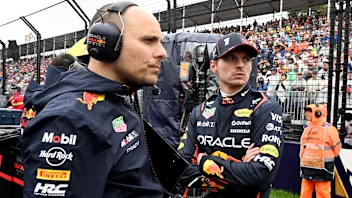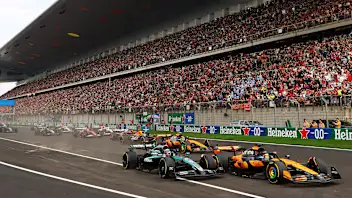Testing analysis - the big talking points from Jerez
Last week’s opening pre-season test in Spain was arguably the most anticipated in Formula One history - and it didn’t disappoint, with the new 1.6-litre turbo-powered cars provoking plenty of discussion. We look back over the major talking points, from Red Bull’s struggles to Kevin Magnussen’s impressive showing for McLaren…
Red Bull under pressure
In the past few years, Red Bull have been famous for rewriting the record books in dazzling style, but their tally of 21 laps in four days in Jerez is a statistic that the reigning world champions will be eager to forget. In a year when reliability is expected to be a key factor in race results (Red Bull team principal Christian Horner even went as far as saying that he wouldn’t be surprised if half the field retired from the first race in Australia), the Milton Keynes-based squad’s struggles with chassis cooling and their issues with the new Renault power unit (see below) have immediately put them on the back foot.
Whilst the RB10 was sitting in the garage in Jerez, their chief rivals were chalking up mileage and gathering priceless information about their new cars - some, like Mercedes, even managed to complete a race simulation run. Can the issues be fixed in time for the second test in Bahrain on February 19-22? The answer to that is unclear. After all, Renault had hoped to solve one of the problems on the ground in Jerez but couldn’t. Changes to the RB10’s packaging might help the overheating issues, but that’s not necessarily an easy thing to achieve.
Overall, whilst it’s not time to push the panic button just yet, Adrian Newey and his technical team will have to work flat out over the next few weeks to get the RB10 in proper working order for the next test in Bahrain.
Renault’s teething troubles
It wasn’t just Red Bull who had issues in Jerez - the other Renault runners, Toro Rosso and Caterham, were also blighted by various power unit problems that interfered with their programmes. In total, the three teams using the French manufacturer’s power unit managed 151 laps in four days: 76 for Caterham, 54 for Toro Rosso, and 21 for Red Bull. By contrast, Mercedes’ four teams clocked 875 laps and Ferrari’s three teams, 444 (and that was despite Marussia not running until Thursday afternoon).
It must be said that ironing out such issues is exactly why the teams test in the first place, and with the complexity of the new power units, some problems were anticipated. However, with their rivals running so well (see below), the pressure is on Renault to come up with the necessary fixes in time for Bahrain or risk dropping further behind.
A positive start for Mercedes’ new power unit - and Ferrari’s
As mentioned above, the new V6 power units - with their dual energy recovery systems, turbocharger and battery storage - are incredibly complex pieces of kit, so the fact that the Mercedes- and Ferrari-powered teams were able to complete so many laps is a testament to the work done behind the scenes at Brixworth and Maranello.
Mercedes look to be in a particularly strong position - not only did their units complete nearly double the mileage of their Ferrari rivals (albeit with the help of an extra team), they also had the top four times of the week. The works Silver Arrows squad were, perhaps unsurprisingly, the stand-outs in terms of mileage, with Nico Rosberg completing a trouble-free race simulation run on the final day.
But remember: it’s very early days. Ferrari’s power unit was quietly impressive in Spain, whilst Renault - who have powered Red Bull to the championship double for the last four years lest we forget - may well bounce back in Bahrain.
Diversity rules
Not everyone appreciates the look of the 2014 cars, but as the covers came off each of the new machines in Jerez, no one could doubt the diversity on display, particularly at the front of the cars.
Some are clearly more aesthetically-pleasing than others (we’ll let you make your own minds up about which ones), but it’s refreshing to see how each team has interpreted the rule book in a different way. So far, the ‘finger’ nose seems to be particularly popular, but even those show considerable variety - just look at the front of the Force India compared to the Toro Rosso.
Magnussen’s impressive beginning
Whilst it’s wrong to read too much into testing times, it would also be wrong to overlook the promising performance of McLaren’s Danish rookie Kevin Magnussen in Jerez.
Despite his limited F1 experience, the 21-year-old not only clocked the fastest lap of the week, but also cut a calm and relaxed figure in the paddock. He had a minor off on the final afternoon of the test, but overall it was hard not to be impressed by his debut outing as a McLaren race driver.
Adjusting to the new cars
Whilst fans in Jerez were adapting to the different look and sound of the 2014 cars, the drivers were adapting to how different they are to drive compared to their 2013 cousins. Don’t forget, as well as the new power units - producing different amounts of power and delivering different levels of torque - the new cars also feature eight-speed gearboxes, revised aerodynamics and a new braking system.
“The car matched my expectations on track with more torque,” said Williams’ Valtteri Bottas. “It feels like a very different car compared to last year in the way it handles as well as the power.”
McLaren’s Jenson Button agreed with the Finn’s assessment:
"It feels the most powerful engine I've driven,” said the Briton. “It obviously isn't in terms of outright power, but as a racing driver you feel the torque and power at slow speed. It's coming out of the corners when you have so much torque that's exciting."
But the drivers won’t just be using their steering wheels to control a potential increased number of slides; they’ll be using them to manage several elements of car performance, including switching between engine maps to save fuel during races.
“The steering wheel is completely different; it's almost like a smartphone with all the information on it!” exclaimed Mercedes’ Nico Rosberg.
“We have to understand what every button does, how each system works, and how you can get a benefit from that,” said Sauber’s Esteban Gutierrez. "That is what's going to make the difference."
McLaren reveal innovative suspension design
As a team McLaren have always been one of the most innovative in Formula One racing, so it seemed apt that it was one of the design elements on their MP4-29 that had tongues wagging in Jerez. The big talking point was the car’s rear suspension, and in particular the toe link and the rear leg of the lower wishbone which, by virtue of their profile, are in effect large aero devices.
The theory is that at lower speeds these suspension fairings help improve the extraction of air from the rear diffuser, thus boosting downforce, while at higher speeds movement in the suspension components means they cut drag. It’ll be interesting to see how many teams follow McLaren’s lead, although at this stage it’s difficult to tell just how effective the suspension fairings really are.
Next Up
Related Articles
 Verstappen pays tribute to Lambiase after ‘emotional year’
Verstappen pays tribute to Lambiase after ‘emotional year’/Untitled-10.webp) Bottas embarks on first day as a Cadillac driver
Bottas embarks on first day as a Cadillac driver.webp) VOTE: Choose your favourite race of the 2025 season
VOTE: Choose your favourite race of the 2025 season Norris collects World Championship trophy at FIA Awards
Norris collects World Championship trophy at FIA Awards Tickets on sale for 2026 Chinese Grand Prix
Tickets on sale for 2026 Chinese Grand Prix ‘I have achieved my dream, that little boy's dream’ – Norris
‘I have achieved my dream, that little boy's dream’ – Norris